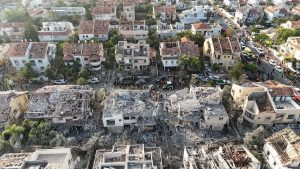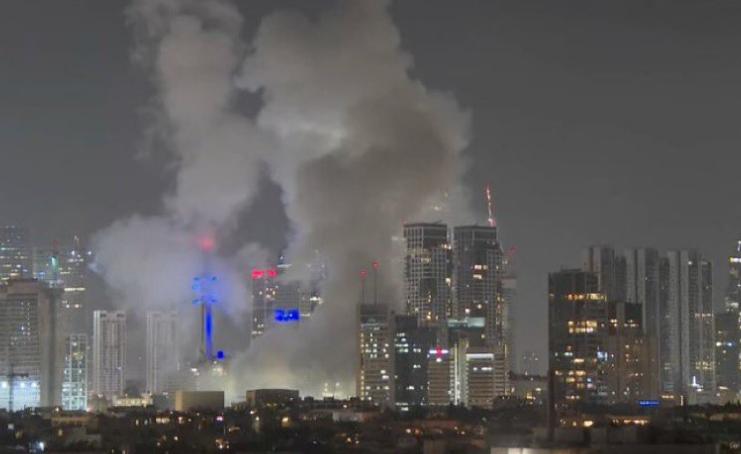Iran strikes Tel Aviv with missile barrage in retaliation for Israeli attack on nuclear sites
Summary
- At least three killed and dozens injured as missiles hit Tel Aviv and surrounding areas
- Iran launches over 100 missiles in “Operation True Promise 3” after Israeli airstrikes on nuclear facilities
- Israel and allies intercept many missiles, but key urban and military areas suffer damage
- Escalation raises fears of regional conflict, as international calls for de-escalation grow
Tel Aviv — On June 13, 2025, Iran launched a major missile strike on Israel in response to Israeli airstrikes earlier the same day targeting Iran’s nuclear facilities and military infrastructure.
The Iranian retaliation, named “Operation True Promise 3” or “Operation Severe Punishment,” involved launching an estimated 100 to 150 ballistic missiles in successive waves aimed at Tel Aviv, Jerusalem, and other strategic areas.
Casualties and damage in Israel
At least three people were confirmed dead, including a woman, and between 34 and 63 others were injured, primarily from shrapnel. The injuries ranged from minor to critical, with one critically injured person later succumbing to their wounds.
Multiple residential and high-rise buildings in Tel Aviv, including structures in the suburb of Ramat Gan, sustained significant damage. Fires broke out, windows were shattered, and emergency services reported structural damage to homes and vehicles. Firefighters worked through the night, rescuing individuals trapped in the debris.
 Significantly damaged structures in the suburb of Ramat Gan
Significantly damaged structures in the suburb of Ramat Gan
Missiles also landed near key military sites, including the Israeli Defense Forces (IDF) headquarters and the Marganit Tower in Tel Aviv’s Kirya area. While some sensitive locations were hit, others, including the Mossad headquarters, reportedly escaped direct damage.
Israeli and allied defense response
Israel deployed its multi-tiered defense systems, Iron Dome and Arrow, to intercept the barrage. According to the IDF, most incoming missiles were intercepted or fell short, but at least seven impact sites were confirmed around Tel Aviv.
The U.S. military provided assistance, with its ground-based air defense systems active in helping repel the assault, and other regional allies reportedly contributed as well.
Emergency services, including Magen David Adom (MDA), were on high alert. First responders treated the injured and evacuated residents. One MDA mobile unit was hit by shrapnel, injuring two crew members.
Iran’s claims and motivations
Iran’s Islamic Revolutionary Guard Corps (IRGC) claimed that the strikes successfully hit military-industrial centers, airbases, and strategic Israeli targets. Iranian state media described the attack as the “beginning of a crushing response” to Israel’s pre-dawn airstrikes, which reportedly killed 78 people, including high-ranking IRGC officers Hossein Salami and Mohammad Bagheri, as well as several nuclear scientists.
Supreme Leader Ayatollah Ali Khamenei vowed that Israel would face “harsh punishment,” framing the Iranian response as a necessary defense against what he termed Israeli “warfare.” At the UN, Iran’s ambassador Amir Saeid Iravani labeled the attack a legitimate act of self-defense under international law.
Background and context of escalation
The missile exchange came after Israel launched “Operation Rising Lion,” a massive aerial assault involving more than 200 fighter jets, including F-35s. The Israeli strike targeted Iran’s nuclear facilities at Natanz and Isfahan, as well as military installations, aiming to disrupt what Israeli officials claim is an imminent nuclear weapons capability. The aboveground enrichment plant at Natanz was reportedly destroyed, with chemical and radiological contamination reported.
Despite the scale of the attack, Israeli officials provided no evidence of an imminent Iranian threat, raising international questions about the preemptive nature of their operation. Iran’s retaliation, in turn, has heightened fears of a prolonged and potentially region-wide conflict.
By early June 14, hostilities continued, with Iran launching a second wave of missiles and Israel conducting further airstrikes on Iranian positions.
International and regional reactions
The United States condemned Iran’s missile strikes and warned against any actions threatening American interests in the region. European leaders, including EU Commission President Ursula von der Leyen and German Chancellor Friedrich Merz, urged immediate de-escalation.
Russia’s President Vladimir Putin offered to mediate between the two countries. While he criticized Israel’s initial strike, he also cautioned against further escalation.
China and Brazil condemned Israel’s actions as violations of Iranian sovereignty, while countries like the Czech Republic defended Israel’s right to neutralize nuclear threats.
The UN’s nuclear watchdog, the IAEA, emphasized that nuclear facilities should never be military targets. A scheduled UN conference on the Israel-Palestine two-state solution was postponed, and U.S.-Iran nuclear talks set for June 15 in Oman were suspended.
Wider impact on the region and beyond
Airspace closures over Iran, Israel, Lebanon, and Iraq disrupted regional travel, while oil prices surged by 7 to 14 percent amid fears of supply interruptions. Social media and live footage captured the intensity of the assault, with missiles streaking across the night sky and explosions rocking Tel Aviv.
Conflicting reports and propaganda
Discrepancies in the reported number of missiles and casualties highlight the fog of war and information control. While Iran’s state media touted the success of its strikes, many claims remain unverified. Conversely, Israeli officials sought to downplay the extent of the damage, especially to military infrastructure.
Both governments have portrayed their actions as defensive, complicating efforts to objectively assess events. Analysts warn that despite Israel’s show of force, Iran’s nuclear program may only be temporarily disrupted, and its weakened regional proxies may limit further escalation. However, risks remain high, particularly if Iran resorts to international terrorism or if U.S. interests are directly targeted.
As of June 14, the situation remains volatile, with the potential for further escalation and broader conflict still looming.







